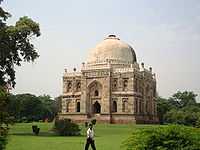Lodhi colony
Lodhi Colony (Hindi:लोधी कालोनी] (Urdu:لودی کالونی) is a Central Government Officers and Staff Residential Colony in South Central part of New Delhi, built in the 1940s, and lies close to Lodhi Road.[1]
History

Education
Speaking of students, Lodhi Colony has many centres nearby, for higher education, such as 'the All India Management Association (AIMA) institute, the Alliance Française de Delhi and even an off-campus Delhi University college, the Dyal Singh College. Comparatively low amount of vehicular traffic except on the main colony road (Max Mueller Marg) makes the colony a pedestrian/walker's heaven.
Visitor's attractions
There are several places to visit in the vicinity such as the Sai Baba Temple of Lodhi Road, Khan Market, Jor Bagh, the 16th century Tomb of Sikander Lodhi, situated in Lodhi Gardens and the India Habitat Centre. There are several municipal parks including Charbagh which features the Lodhi Gardens.
The three main shopping markets in this area are Khanna Market and Meherchand Market. Chocolate Wheel Confectionary in the Jor Bagh area is a very popular bakery. Rajiv Gandhi used to buy cakes from here.
References
- ↑ 1.0 1.1 1.2 "A tale of two cities". Hindustan Times. September 01, 2011.
Coordinates
28°34'57"N 77°13'25"E